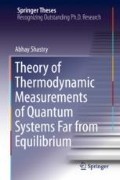Abstract
In Chap. 2 we found that the second law of thermodynamics imposes strong restrictions on what can be considered a meaningful thermodynamic measurement. We ask a question motivated by the third law of thermodynamics: What is the coldest possible temperature one can measure in a nonequilibrium quantum system? We have discussed how to measure temperature and voltage in the previous chapter. Most importantly, we realized that temperature and voltage have to be measured simultaneously to ensure uniqueness of the measurement. Here we show that absolute zero cannot be reached for a nonequilibrium quantum system, but arbitrarily low temperatures are, in principle, possible. In quantum coherent conductors, low temperatures result locally when there is destructive interference of “hot” electrons.
Access this chapter
Tax calculation will be finalised at checkout
Purchases are for personal use only
Notes
- 1.
The exact solution to the Eq. (3.30) with T 1 → 0 is
$$\displaystyle \begin{aligned} T_{p}=T_{2}\left(\frac{\sqrt{1 + 4\lambda_{1}^{2}}-1}{2\lambda_{1}}\right)^{\frac{1}{2}}, \end{aligned}$$where λ 1 is defined in Eq. (3.39) and simplifies to
$$\displaystyle \begin{aligned} \lambda_{1}=\frac{7\pi^{2}}{20}\frac{\mathcal{T}_{p2}^{(2)}(k_{B}T_{2})^{2}}{\mathcal{T}_{p1}}, \end{aligned}$$a factor that appears in Eq. (3.32).
- 2.
It is necessary to minimize the ratio of transmissions to find the temperature minima since it is computationally prohibitive to calculate the temperatures at various points in the search space, within each iteration of the optimization algorithm.
- 3.
I would like to thank Justin Bergfield for modeling the tip-sample coupling.
References
A. Shastry, C.A. Stafford, Phys. Rev. B 92, 245417 (2015). https://doi.org/10.1103/PhysRevB.92.245417. http://link.aps.org/doi/10.1103/PhysRevB.92.245417
J.P. Bergfield, S.M. Story, R.C. Stafford, C.A. Stafford, ACS Nano 7(5), 4429 (2013). https://doi.org/10.1021/nn401027u
J. Meair, J.P. Bergfield, C.A. Stafford, P. Jacquod, Phys. Rev. B 90, 035407 (2014). https://doi.org/10.1103/PhysRevB.90.035407. http://link.aps.org/doi/10.1103/PhysRevB.90.035407
J.P. Bergfield, C.A. Stafford, Phys. Rev. B 90, 235438 (2014). https://doi.org/10.1103/PhysRevB.90.235438. http://link.aps.org/doi/10.1103/PhysRevB.90.235438
J.P. Bergfield, M.A. Ratner, C.A. Stafford, M. Di Ventra, Phys. Rev. B 91, 125407 (2015). https://doi.org/10.1103/PhysRevB.91.125407. http://link.aps.org/doi/10.1103/PhysRevB.91.125407
C.A. Stafford, Phys. Rev. B 93, 245403 (2016). https://doi.org/10.1103/PhysRevB.93.245403. http://link.aps.org/doi/10.1103/PhysRevB.93.245403
A. Shastry, C.A. Stafford, Phys. Rev. B 94, 155433 (2016). https://doi.org/10.1103/PhysRevB.94.155433. http://link.aps.org/doi/10.1103/PhysRevB.94.155433
J.K. Viljas, J.C. Cuevas, F. Pauly, M. Häfner, Phys. Rev. B 72(24), 241201(R) (2005)
M. Büttiker, Phys. Rev. Lett. 57, 1761 (1986)
U. Sivan, Y. Imry, Phys. Rev. B 33, 551 (1986). https://doi.org/10.1103/PhysRevB.33.551. http://link.aps.org/doi/10.1103/PhysRevB.33.551
S. Datta, Electronic Transport in Mesoscopic Systems (Cambridge University Press, Cambridge, 1995)
J. Heurich, J.C. Cuevas, W. Wenzel, G. Schön, Phys. Rev. Lett. 88, 256803 (2002)
J.P. Bergfield, C.A. Stafford, Phys. Rev. B 79(24), 245125 (2009)
J.P. Bergfield, M.A. Solis, C.A. Stafford, ACS Nano 4(9), 5314 (2010)
Y. Dubi, M. Di Ventra, Phys. Rev. E 79, 042101 (2009). https://doi.org/10.1103/PhysRevE.79.042101. http://link.aps.org/doi/10.1103/PhysRevE.79.042101
Y. Dubi, M. Di Ventra, Nano Lett. 9(1), 97 (2009)
Y.J. Yu, M.Y. Han, S. Berciaud, A.B. Georgescu, T.F. Heinz, L.E. Brus, K.S. Kim, P. Kim, Appl. Phys. Lett. 99(18), 183105 (2011). http://dx.doi.org/10.1063/1.3657515. http://scitation.aip.org/content/aip/journal/apl/99/18/10.1063/1.3657515
K. Kim, J. Chung, G. Hwang, O. Kwon, J.S. Lee, ACS Nano 5(11), 8700 (2011). https://doi.org/10.1021/nn2026325. http://dx.doi.org/10.1021/nn2026325. PMID: 21999681
K. Kim, W. Jeong, W. Lee, P. Reddy, ACS Nano 6(5), 4248 (2012). https://doi.org/10.1021/nn300774n. http://dx.doi.org/10.1021/nn300774n. PMID: 22530657
F. Menges, H. Riel, A. Stemmer, B. Gotsmann, Nano Lett. 12(2), 596 (2012). https://doi.org/10.1021/nl203169t. http://dx.doi.org/10.1021/nl203169t. PMID: 22214277
A. Caso, L. Arrachea, G.S. Lozano, Phys. Rev. B 81(4), 041301 (2010). https://doi.org/10.1103/PhysRevB.81.041301
A. Caso, L. Arrachea, G.S. Lozano, Phys. Rev. B 83, 165419 (2011). https://doi.org/10.1103/PhysRevB.83.165419. http://link.aps.org/doi/10.1103/PhysRevB.83.165419
H. Song, Y. Kim, Y.H. Jang, H. Jeong, M.A. Reed, T. Lee, Nature 462(7276), 1039 (2009). http://dx.doi.org/10.1038/nature08639
L.G.C. Rego, G. Kirczenow, Phys. Rev. Lett. 81(1), 232 (1998)
L.G.C. Rego, G. Kirczenow, Phys. Rev. B 59(20), 13080 (1999)
C.J. Chen, Introduction to Scanning Tunneling Microscopy, 2nd edn. (Oxford University Press, New York, 1993)
Author information
Authors and Affiliations
Rights and permissions
Copyright information
© 2019 Springer Nature Switzerland AG
About this chapter
Cite this chapter
Shastry, A. (2019). Coldest Measurable Temperature. In: Theory of Thermodynamic Measurements of Quantum Systems Far from Equilibrium. Springer Theses. Springer, Cham. https://doi.org/10.1007/978-3-030-33574-8_3
Download citation
DOI: https://doi.org/10.1007/978-3-030-33574-8_3
Published:
Publisher Name: Springer, Cham
Print ISBN: 978-3-030-33573-1
Online ISBN: 978-3-030-33574-8
eBook Packages: Physics and AstronomyPhysics and Astronomy (R0)

